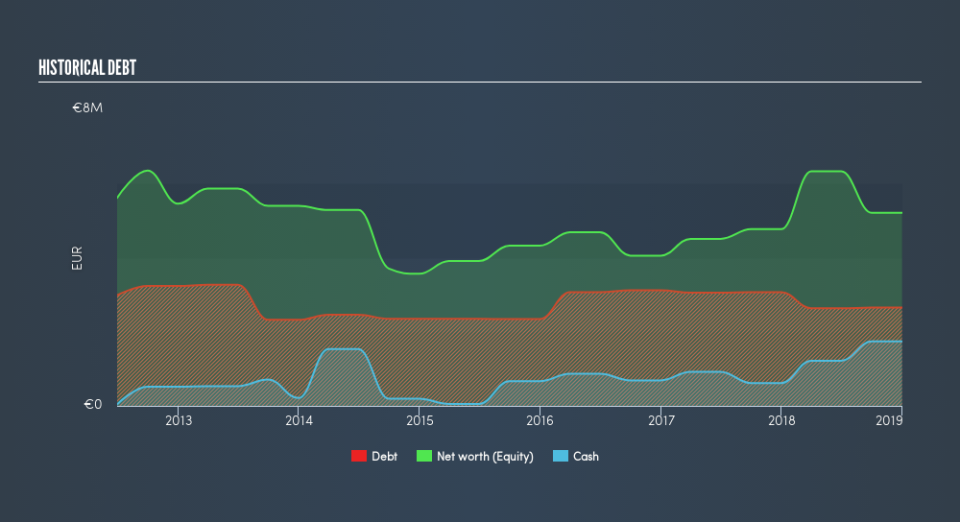Is RoodMicrotec N.V.'s (AMS:ROOD) Balance Sheet A Threat To Its Future?

While small-cap stocks, such as RoodMicrotec N.V. (AMS:ROOD) with its market cap of €16m, are popular for their explosive growth, investors should also be aware of their balance sheet to judge whether the company can survive a downturn. Understanding the company's financial health becomes essential, since poor capital management may bring about bankruptcies, which occur at a higher rate for small-caps. Let's work through some financial health checks you may wish to consider if you're interested in this stock. Nevertheless, this is just a partial view of the stock, and I recommend you dig deeper yourself into ROOD here.
Want to participate in a short research study? Help shape the future of investing tools and you could win a $250 gift card!
ROOD’s Debt (And Cash Flows)
Over the past year, ROOD has reduced its debt from €3.1m to €2.7m , which includes long-term debt. With this debt repayment, ROOD's cash and short-term investments stands at €1.7m , ready to be used for running the business. Additionally, ROOD has produced €563k in operating cash flow during the same period of time, resulting in an operating cash to total debt ratio of 21%, indicating that ROOD’s debt is appropriately covered by operating cash.
Does ROOD’s liquid assets cover its short-term commitments?
With current liabilities at €2.5m, it appears that the company has been able to meet these obligations given the level of current assets of €4.4m, with a current ratio of 1.78x. The current ratio is calculated by dividing current assets by current liabilities. Usually, for Semiconductor companies, this is a suitable ratio since there is a bit of a cash buffer without leaving too much capital in a low-return environment.
Can ROOD service its debt comfortably?
With a debt-to-equity ratio of 51%, ROOD can be considered as an above-average leveraged company. This is a bit unusual for a small-cap stock, since they generally have a harder time borrowing than large more established companies. We can check to see whether ROOD is able to meet its debt obligations by looking at the net interest coverage ratio. A company generating earnings before interest and tax (EBIT) at least three times its net interest payments is considered financially sound. In ROOD's, case, the ratio of 2.05x suggests that interest is not strongly covered, which means that lenders may refuse to lend the company more money, as it is seen as too risky in terms of default.
Next Steps:
Although ROOD’s debt level is towards the higher end of the spectrum, its cash flow coverage seems adequate to meet obligations which means its debt is being efficiently utilised. Since there is also no concerns around ROOD's liquidity needs, this may be its optimal capital structure for the time being. I admit this is a fairly basic analysis for ROOD's financial health. Other important fundamentals need to be considered alongside. I suggest you continue to research RoodMicrotec to get a more holistic view of the small-cap by looking at:
Future Outlook: What are well-informed industry analysts predicting for ROOD’s future growth? Take a look at our free research report of analyst consensus for ROOD’s outlook.
Valuation: What is ROOD worth today? Is the stock undervalued, even when its growth outlook is factored into its intrinsic value? The intrinsic value infographic in our free research report helps visualize whether ROOD is currently mispriced by the market.
Other High-Performing Stocks: Are there other stocks that provide better prospects with proven track records? Explore our free list of these great stocks here.
We aim to bring you long-term focused research analysis driven by fundamental data. Note that our analysis may not factor in the latest price-sensitive company announcements or qualitative material.
If you spot an error that warrants correction, please contact the editor at editorial-team@simplywallst.com. This article by Simply Wall St is general in nature. It does not constitute a recommendation to buy or sell any stock, and does not take account of your objectives, or your financial situation. Simply Wall St has no position in the stocks mentioned. Thank you for reading.

